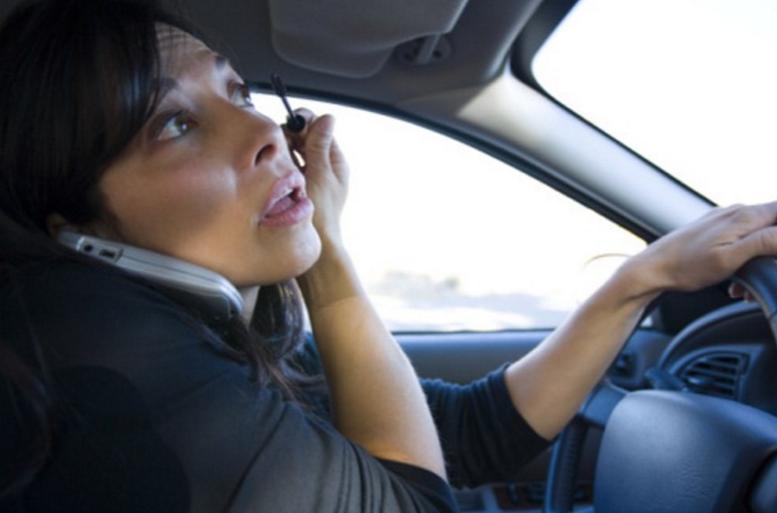Despite fines that reach a maximum of $175 for those who use a mobile device while driving, Marylanders just can’t seem to stay off their phones when behind the wheel.
About 80 percent of Maryland drivers polled admitted to talking on the phone while driving within the preceding 30-day period, and 46 percent of those surveyed reported the same about texting, according to a 2014 study from the AAA Foundation for Traffic Safety.
Two-thirds of surveyed drivers nationwide said they talked on their phone while driving during that same 30-day period. And 33 percent admitted they had texted over the previous 30 days while operating a motor vehicle, according to the AAA survey.
John Townsend, a spokesman for AAA, emphasized that the number may be even higher than reported in the survey.
“These are just the people who confess — out of their own lips and mouths they confess their own transgressions,” Townsend said. “It is pandemic nationwide, and it is pandemic in the state of Maryland.”
Delegate Frank Turner, D-Howard, said driving while using a handheld mobile device — for which 40,479 citations were issued in fiscal year 2015, according to data from the state’s District Court — is still all-too-common among Maryland drivers.
So Turner decided to do something about it.
Turner’s bill, “Use of Handheld Telephone While Driving,” introduced in the state House Environment and Transportation Committee on Feb. 11, would double the current maximum fine for distracted driving to $150 for first-time offenders, $250 for second-time offenders and $350 for third-time offenders and beyond. Under current law, the maximum fine is $75, $125 and $175, respectively.
“I see (distracted driving) all the time and other people see it too,” Turner said. “$75 doesn’t seem to be enough to get people off their phones, but maybe $150 will.”
But there is at least one encouraging trend. Data from the Maryland Motor Vehicle Administration also shows that deaths from distracted driving in Maryland have been on a steady decline since 2004.
From 2004 to 2008, the annual average number of fatalities was 333, compared with 232 from 2009 to 2013, a 30 percent reduction. Injuries, too, have been decreasing, starting at an annual average of 4,134 in 2004-2008 before falling 43 percent to the 2009-2013 average of 2,348.
The issue of distracting driving is all-too-familiar for Joel Feldman, the co-founder of End Distracted Driving, a national group that seeks to promote safe driving habits through advocacy and education.
The 2009 death of his daughter, Casey Feldman, caused after a driver reached down for his GPS and subsequently slammed into Casey’s car in New Jersey, led Feldman and Casey’s mom, Dianne Anderson, to seek a solution.
“After a couple of weeks I started wondering: Why did this happen, how could this happen?” Feldman said. “I started thinking, ‘Oh my God, I used to text while driving.’ It started a journey to figure out what texting and driving is all about and why people do it.”
Seven years later, Feldman’s organization boasts nearly 500 trained speakers who have given presentations on the dangers of distracted driving in 43 states and multiple Canadian provinces. The group’s speeches put special emphasis on parents, Feldman said.
There is reason to believe that the lax attitude some parents have about using handheld devices while driving can influence their children, Feldman said, recalling a conversation he had with a mother of a 5-year-old girl.
“She said her little girl won’t drive in her Fisher Price Car unless her mommy gives her the cellphone,” Feldman said.
Looking at the younger generation, Feldman says he is excited about the prospect of reducing distracted driving in the future.
“The millennials I see are more interested in social causes and changing their world,” he said. “I think they can change this, because they care so much about each other and they care so much about the world. I am optimistic.”
Turner is not as positive about the effect his bill, which is awaiting a vote in a House subcommittee, could have on texting and driving among state motorists.
“I don’t think that this is going to totally solve the problem,” Turner said. “I mean, people are still driving and they are still using their phones like we never passed the (first) bill.”
As driving while using a handheld mobile device remains a common practice, Townsend said, all state motorists should first took a hard look at themselves and their actions.
“The distracted driver; that’s the thing we fear the most,” Townsend said. “And guess what? The thing we fear the most is us.”
Josh Magness



joe diamond says
Let us not leave the cops out of the discussion,
Yes they have a dangerous but necessary job. But even with the danger of confronting aggressive individuals the statistics do not indicate police fatalities are crime related. It is auto crashes that kills off the cops. They sit on their seat belts. They use several radios and cell phones while driving & have on board computers within the view of the driver in the cop cars.
So let them lead this. Whatever is done to keep officers safe should filter down to the peasant level.
The other part is that this law is almost unenforceable. There is clearly a need for limiting gadget use while driving but asking cops to discover violations is a stretch.
My opinion only,
Joe